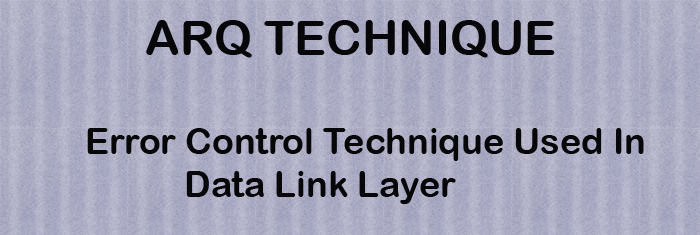ARQ Technique: Error Control Techniques In the Datalink layer.
Hello friends, In this blog post(Error Control Techniques In the Datalink Layer), I am going to let you know about the elementary data link layer protocols. We will explain the ARQ technique which is used for error control in the data link layer.
In this blog post(Error Control Techniques In the Datalink layer), we will see What are the two types of ARQ. How is ARQ used in error detection? At what layer does ARQ exist? How does an ARQ check work?
In the data link layer, error correction is implemented through the combined application of an error detection mechanism, an ACK showing successful receipt of a frame,…|Error Control Techniques In the Datalink layer|
a negative acknowledgement (NAK) showing unsuccessful receipt of a frame, and the specification of which frames are in error.
These mechanisms are collectively known as Automatic Repeat Requests (ARQ). There are three ARQ techniques-
Stop-and-wait-ARQ
Go-back-N-ARQ
Selective-repeat-ARQ
Stop-and-wait-ARQ:
Stop and wait for ARQ is the simplest transmission protocol. Fundamentally, it uses the stop and waits for the flow control method, but with an additional capability to retransmit lost or corrupted frames.
With this additional feature, the receiver discovers an error in a data frame and returns a NAK to the sender showing that the frame should be retransmitted.
Thus, the source sends out one frame and then waits until it receives either an ACK or an NAK before transmitting the next frame.
The sending device is equipped with a timer which indicates how long it should take for an acknowledgement to come back.
If none is received within the allotted time, the source assumes the last data frame was lost in transit and retransmits it.
Because the stop-and-wait mechanism is very inefficient, It is not widely used.
Go-back-N-ARQ:
Go back N ARQ is based on the sliding window flow control, which is also known as continuous ARQ. In this technique, a series of data frames are transmitted continuously without waiting for an acknowledgement.
Number N specifies the number of successive frames which can be transmitted in the absence of an ACK or a NAK.
If the receiving station detects an error in a frame, it transmits an NAK to the transmitter for that frame.
Then, the receiver discards all further incoming frames, whether or not they are good, and how to wait to receive correctly the frame which was in error before accepting any other frames.
When the transmitting station receives an NAK, it must retransmit the frame in question plus all succeeding frames.
Therefore, the name go-back-N, because frames which were transmitted after the damaged frame also must be retransmitted.
When an error takes place, this may affect up to N previously transmitted frames.
As is the case with stop-and-wait-ARQ, the go-back-N ARQ uses a timer mechanism which informs the transmitter how long it should wait for an acknowledgement to co,e back before it resends unacknowledged frames.
Select Repeat ARQ:
In the selective repeat ARQ, only the specific lost or damaged frame is resent. Intuitively this may appear more efficient than the go-back N ARQ, Where all good frames following the error also are resent.
Although this does provide a better performance, the implementation can be quite involved.
The reason is that the receiver has the additional major burdens of storing frames which follow an error, keeping track of which frame was incorrect, and inserting.
The correct retransmitted frame into the appropriate sequence when it arrives.
Because the additional logic required for such a function is costly and complex, to implement, selective repeat ARQ is used much less as compared to going back to N ARQ.
Conclusion:
Using this blog post we have seen the types of ARQ techniques in data link layer protocol. We have discussed What are the two types of ARQ? How is ARQ used in error detection? At what layer does ARQ exist? How does an ARQ check work?|Error Control Techniques In the Datalink Layer |
You can also go through a few more amazing blog links below related to computer networks:
What is meant by piggybacking what are its advantages and disadvantages…
What is meant by flow control…
What is sliding window protocol for example…
‘Stop and wait’ protocol Used In Data Link Layer…
Difference Between Error Control and Flow Control…
What Is Data Link Protocol…
ARQ Technique: Error Control Techniques In the Data link layer…
Error Control Using Data Link Layer In Computer Network…
Flow Control Using Data Link Layer In Computer Network…
HDLC Protocol In Hindi…
In the case of any queries, you can write to us at a5theorys@gmail.com we will get back to you ASAP||
Hope! you would have enjoyed this post about error control techniques in the data link layer|Error Control Techniques In the Datalink layer|
Please feel free to give your important feedback in the comment section below|Error Control Techniques In the Datalink layer|
Have a great time! Sayonara!


